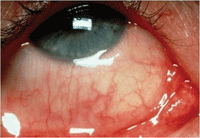With a llergy season around the corner, our practices will soon see the return of runny, itchy and swollen eyes en mass. Allergies are not pleasant for anybody, and the irritation only intensifies when you add contact lenses to the equation. It’s no surprise then that most contact lens wearers avoid their lenses and revert to wearing glasses during the allergy season.
llergy season around the corner, our practices will soon see the return of runny, itchy and swollen eyes en mass. Allergies are not pleasant for anybody, and the irritation only intensifies when you add contact lenses to the equation. It’s no surprise then that most contact lens wearers avoid their lenses and revert to wearing glasses during the allergy season.
The good news is that the battle is not over and there is still hope for the contact lens wearers. They don’t need to wave the white flag. As technology continues to evolve, we now have a host of lens options and treatment paradigms to better manage your allergy-suffering patients.
Proper management of contact lens patients benefits both the patient and the practice. In fact, the prevalence of allergic conjunctivitis has been estimated to be as high as 40%, and discomfort, a common symptom in allergic conjunctivitis patients, is the most common cause associated with contact lens dropouts.1,2 Each contact lens dropout costs an optometric practice an average of $21,695 over the lifetime of that patient.2 These dropouts can be alleviated by working with your patients to find an appropriate treatment plan and contact lens system customized to their needs.

Depending on the location, the signs and symptoms of allergic conjunctivitis can often have common characteristics with other forms of ocular surface disease, including redness and inflammation.
To start, eye care practitioners should be very comfortable in recognizing the classic signs and symptoms of ocular allergy. This may be challenging since ocular allergic disease can be difficult to distinguish from other masquerading eye conditions. Depending on the location, the signs and symptoms of allergic conjunctivitis can often have common characteristics with other forms of ocular surface disease, including redness and inflammation.
The key symptoms of allergic conjunctivitis include itching, tearing, burning, foreign-body sensation and ocular dryness. Itching is the hallmark symptom. If it is absent, the diagnosis of allergic conjunctivitis should be questioned. Seasonal allergic conjunctivitis is often caused by pollen and typically peaks during the spring and summer months, whereas perennial allergic conjunctivitis can last throughout the year and is often instigated by such irritants as dust mites, pet dander and mold.3
Talking with Your Patient
Start by establishing an open line of communication with your patients about allergies and how it affects their contact lens wear. Taking a proactive approach with your patients will help minimize the negative impact of allergic conjunctivitis on successful contact lens wear. A key component of any ocular allergy evaluation is a comprehensive ocular and medical history—this will establish whether a condition is acute, subacute, chronic, recurrent, or related to seasonal or environmental exposure.
Other clues are provided by the presence of recent upper respiratory tract infection, foreign body exposure, trauma and systemic or topical medication use (including vasoconstrictors and artificial tears). When collecting a thorough history, be sure to include questions about the daily environment, whether the allergies are a seasonal issue, at what point in the day the allergies are at their worst, and whether your patient takes any systemic medications.
An Appropriate Treatment Plan
After a comprehensive patient history has been recorded, start discussing appropriate treatment plans for your patient’s allergies and create a customized approach to his or her lens wear. Remember that your patients who suffer some chronic allergy symptoms may require complete disease resolution prior to lens continuation. For patients who have seasonal allergies that make lens wear difficult during certain times of the year even with medication, it may be optimal to discontinue use for a short period of time and resume wear when the symptoms taper off. Once daily antihistamine/mast cell stabilizer combinations, such as Pataday (olopatadine 0.2%, Alcon) and Lastacaft (alcaftadine 0.25%, Allergan), are optimal due to the convenient dosing schedule.
After identifying the proper therapeutic action, the next step is to customize your patient’s lens wear. Note: Allergy sufferers can wear contact lenses, even though it may seem impossible. Popular daily lenses, such as Acuvue Moist (Vistakon) or Dailies AquaComfort Plus (CIBA Vision), are great alternatives for allergy sufferers. Many patients appreciate the convenience and the comfort of having a new lens every day. This modality is safer than their two-week and one-month counterparts because the lenses collect less of a build-up of allergic irritants, and the regimen encourages a much higher compliance rate. One study reported a significant increase in comfort for patients with ocular allergies when they were fit with daily disposable contact lenses.4
Often, the best defense is a good offense. With peak allergy season around the corner, now is a good time to reevaluate contact lens-wearing patients who have ocular allergies. Whether your patient has previously worn contact lenses and discontinued wear due to allergies, is a first-time contact lenses wearer or is currently suffering with allergy-related discomfort, prompt education and treatment is critical.
Differentiating between allergic disease and other ocular issues, conducting a comprehensive patient questionnaire and establishing an appropriate treatment plan are crucial steps to take when working with an allergy sufferer. Factor in today’s new lenses and your practice will be equipped with the ability to drastically reduce contact lens dropouts.
1. Kumar P, Elston R, Black D, et al. Allergic rhinoconjunctivitis and contact lens intolerance. Clao J.1991 Jan;17(1):31-4.
2. Rumpakis J. New data on contact lens dropouts: an international perspective. Rev Optom. 2010 Jan;147(1):37-42.
3. Abelson MB, George MA, Garofalo C. Differential diagnosis of ocular allergic disorders. Ann Allergy. 1993 Feb;70(2):95-109.
4. Stiegemeier M., Thomas S. Seasonal allergy relief with daily disposable lenses. CL Spectrum. 2001 Apr;16(4):24-8.


